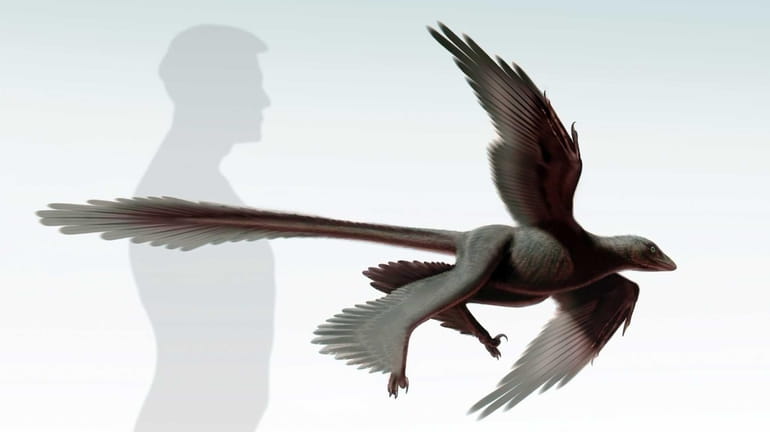Dinosaur fossil with long feathers gives insight into prehistoric flight

A four-winged, meat-eating dinosaur with long tail feathers apparently glided through the air, and its fossil is providing new insights into prehistoric flight, scientists reported. Credit: Getty Images
A four-winged, meat-eating dinosaur with long tail feathers apparently glided through the air, and its fossil is providing new insights into prehistoric flight, scientists reported Tuesday.
The creature is a microraptor, a small cousin to the ferocious and fleet-footed Velociraptor, which quickly made meals out of slower dinosaurs when Earth was a young and very different place.
Alan Turner, an assistant professor of anatomical sciences at Stony Brook University's medical school, collaborated with an international team to provide a unique glimpse into primordial flight.
The scientists reported their findings on the new species they've named Changyuraptor yangi in Tuesday's edition of Nature Communications.
"We know it had feathers because the feathers were preserved on the fossil," said Turner, who called that discovery "remarkable."
Now he and his colleagues are trying to definitively determine how a 4-foot-long, 9-pound animal circumnavigated the air 125 million years ago.
Changyuraptor yangi was found last year in a rich fossil site in the Liaoning province of northeastern China, Turner said, underscoring that the location has seen a surge in discoveries of feathered dinosaurs over the past decade.
When it was unearthed, the entire Changyuraptor fossil was cloaked in a full set of feathers, including foot-long tail plumes that apparently played into the way it moved through space, scientists said.
The creature gets its name from the Chinese words "chang yu," which mean long feathers.
"The hallmark of this fossil are these massively long feathers coming off its tail," said Turner, who was trained as a paleontologist but teaches human anatomy at Stony Brook.
"A femur is still a femur and a tibia, a tibia," Turner said of bones that make up the legs in Cretaceous-era dinosaurs as well as modern humans.
Paleontologist Luis Chiappe of the Natural History Museum in Los Angeles, the project's lead investigator, suggests the tail feathers were instrumental for decreasing descent speed and navigating safe landings. No one, however, knows for sure.
The hope is to construct a simulated version of the beast to determine whether Changyuraptor launched itself and flew or dropped into the wind and glided. The latter scenario so far has the strongest scientific support.
"The amazing tail feathers of Changyuraptor are by far the longest of any feathered dinosaur," Chiappe said. "Clearly far more evidence is needed to understand the nuances of dinosaur flight."
In addition to Turner and Chiappe, the team of investigators includes Anusuya Chinsamy of the University of Cape Town in South Africa, who analyzed the animal's bones with the aim of determining its age. The conclusion: Changyuraptor was an adult.
Mike Habib of the University of Southern California worked on aerodynamic analysis.
Turner, who specialized in finding where Changyuraptor fits in dinosaurs' evolutionary tree, believes it's distant kin to modern birds but lacked the finesse of modern birds in flight.
"Flying in modern birds is a very complex behavior," Turner said.
Gilgo-related search for remains expands ... Congestion pricing target date ... Suffolk air quality ... A dog's bucket list
Gilgo-related search for remains expands ... Congestion pricing target date ... Suffolk air quality ... A dog's bucket list
